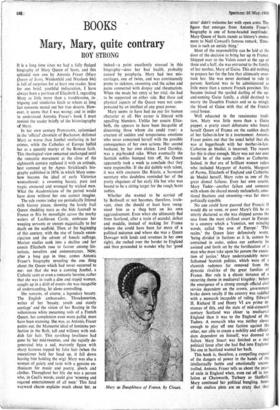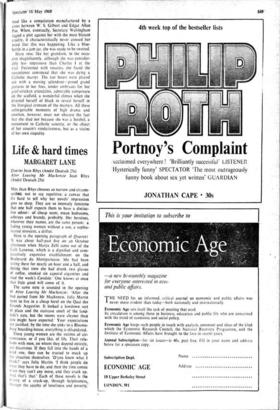Mary, Mary, quite contrary BOOKS
ROY STRONG
It is a long time since we had a fully fledged biography of Mary Queen of Scots, and this splendid new one by Antonia Fraser (Mary Queen of Scots, Weidenfeld and Nicolson 84s) is full of surprises for at least one reader. Save for one brief, youthful indiscretion, I have always been a partisan of Elizabeth I, regarding Mary as little more than a troublesome, in- triguing and vindictive bitch to whom at long last someone meted out her true deserts. How- ever, it seems that I was wrong; and in order to understand Antonia Fraser's book I must remind the reader briefly of the historiography of Mary.
In her own century Protestants, epitomised in the 'official' chronicle of Buchanan, defamed Mary as worse than Jezebel sweltering in her crimes, while the Catholics of Europe hailed her as a queenly martyr of the Roman faith. This theological view remained unchanged until the romantic movement at the close of the eighteenth century replaced it with an attitude, best summed up by Agnes Strickland's bio- graphy published in 1854, in which Mary some- how became the ideal of early Victorian womanhood: a swooning beauty, pure and tragic, ensnared and wronged by wicked men. What the Academicians of the period would have done without her one cannot imagine.
The sale rooms today are periodically littered with history pieces, showing the lovely frail Queen shedding tears as she bids farewell to France or flits by moonlight across the murky waters of Lochleven Castle, embraces her weeping servants or sweeps majestically to her death on the scaffold. Then, at the beginning of this century, with the rise of female eman- cipation and the advent of female suffrage, Marian studies sank into a decline and her cousin Elizabeth rose to favour among his- torians, novelists and commentators. Now, after a long gap in time, comes Antonia Fraser's biography revealing the one thing about the Queen which had never occurred to me: not that she was a cunning Jezebel, a Catholic saint or even a romantic heroine, rather that she was in truth a dim and stupid woman, caught up in a drift of events she was incapable of understanding, let alone controlling.
She remains, of course, a legendary beauty. The English ambassador, Throckmorton, writes of her 'beauty, youth and stately carriage' and the vision of her floating in the voluminous white mourning veils of a French Queen, her complexion even more pallid, must have been stunning. She was, as Antonia Fraser points out, the Mannerist ideal of feminine per- fection in the flesh, tall and willowy with red- dish fair hair. This ravishing loveliness had gone by her mid-twenties, and she rapidly de- generated into a sad, matronly figure with sharp features topped by false hair (when the executioner held her head up, it fell down leaving him holding the wig). Mary was also a woman of gaiety and taste with a genuine en- thusiasm for music and poetry, jewels and clothes. Throughout her life she was a person who, in Cecil's words, could give 'winning and sugared entertainment of all men.' This fatal wayward charm explains much about her, as indeed—a point excellently stressed in this biography—does her bad health, probably caused by porphyria. Mary had two mis- carriages, one of twins, and was continuously prone to sickness, swooning and the aches and pains connected with dropsy and rheumatism. When she made her entry at her trial, she had to be supported on either side. But these sad physical aspects of the Queen were not com- pensated by an intellect of any great power.
Mary seems to have had no eye for human character at all. Her career is littered with appalling blunders. Unlike her cousin Eliza- beth, she appears to have been incapable of discerning those whom she could trust: a creature of sudden and tempestuous emotions who never concerned herself with the possible consequences of her own actions. Her second husband, by her own choice, Lord Darnley, was a pig-headed rake. When eventually the Scottish nobles bumped him off, the Queen apparently took a week to conclude that they were responsible. If she did dabble with talent, it was with creatures like Riccio, a Savoyard secretary who doubtless reminded her of the pretty elegances of her early life but who was bound to be a sitting target for the rough Scots nobles.
Whether she wanted to be carried off by Bothwell or not becomes, therefore, irrele- vant, since she should at least have recog- nised him as a thug bent on his own aggrandisement. Even when she ultimately fled from Scotland, after a train of scandal, defeat and muddle, instead of making for France (where she could have been far more of a political nuisance and where she was a Queen Dowager with lands and revenues in her own right), she rushed over the border to England and then proceeded to wonder why her 'good Mary as Dauphiness of France, by Cloud. sister' didn't welcome her with open arms. The figure that emerges from Antonia Fraser's biography is one of bone-headed ineptitude: Mary Queen of Scots stands as history's monu- ment to Noel Coward's famous remark, 'Emo- tion is such an untidy thing.'
Most of the responsibility can be laid at the door of the decision to bring her up in France. Shipped over to the Valois court at the age of
three and a half, she was entrusted to the family of her mother, Mary of Guise. This did nothing to prepare her for the fate that ultimately over- took her. She was never destined to rule in person; Scotland was to be administered as
little more than a remote French province. She
became instead the spoiled darling of the up- and-coming Guise family, a child destined to marry the Dauphin Francis and so to mingle the blood of Guise with that of the French royal house.
Well educated in the renaissance tradi- tion, Mary was little more than a Guise puppet, a pretty court debutante who found herself Queen of France on the sudden death of her father-in-law in a tournament. Antonia Fraser points out that the usual belief that she was at loggerheads with her mother-in-law, Catherine de Medici, is incorrect. The reason for this is clear enough. Mary was not nor ever would be of the' same calibre as Catherine. Indeed, in that era of brilliant women rulers who included Margaret of Austria, Margaret of Parma, Elizabeth of England and Catherine de Medici herself, Mary rates as one of the great dismal failures. Even her own cousin. Mary Tudor—another failure and someone with whom she shared moody melancholy, emo- tional fixations and swooning—was far more politically capable.
No one could have guessed that Francis II would die so soon, or poor Mary's life be so utterly shattered as she was shipped across the seas from the most civilised court in Europe to a country which a Venetian, not mincing words, called 'the arse of Europe.' This realm,' the Queen later defensively wrote. 'being divided in factions as it is, cannot be contained in order, unless our authority be
assisted and forth set by the fortification of a man who must take upon his person the execu-
tion of justice.' Mary understandably never
fathomed Scottish politics, which were of a clannish rudeness far removed from the dynastic rivalries of the great families of France. Her rule is a classic instance of a recurring theme in mediaeval kingship: before
the emergence of a strong enough official civil service dependent on the crown, government broke down totally if the country was saddled with a monarch incapable of ruling. Edward II, Richard II and Henry VI are prime in- stances of this, and the state of mid-sixteenth century Scotland was closer to mediaeval England than it was to the England of the Tudors. A monarch who was neither clever
enough to play off one faction against the other, nor able to create a nobility and official- dom dependent on himself, was doomed to failure. Mary Stuart was finished as a real political force after she had fled into England. No one in Scotland wanted her back.
This book is, therefore, a compelling expose of the dangers of power in the hands of the intellectually feeble and emotionally uncon- trolled. Antonia Fraser tells us about the years of exile in England when, even cut off in iso- lation at Chatsworth, Tutbury or Sheffield. Mary continued her political bungling. Some of the endless plots are so crazy that they
read like a compilation manufactured by • a cross between W. S. Gilbert and Edgar Allan Poe. When, eventually, Secretary Walsingham rigged a plot against her with the most blatant crudity, it characteristically never crossed her- mind that this was happening. Like a blue- bottle in a jam jar, she was ready to be swotted.
Mary rose, like her grandson, to the occa- sion magnificently, although she was consider- ably less impressive than Charles I at the trial. Festooned with rosaries, she faced the executioner convinced that she was dying a Catholic martyr. The last hours were played out with a moving splendour—proud grand gestures to her foes, tender embraces for her grief-stricken attendants, admirable composure on the scaffold, a wonderful climax when she divested herself of black to reveal herself in the liturgical crimson of the martyrs. All these unforgettable moments of high drama and emotion, however, must not obscure the fact that she died not because she was a Jezebel, a monument to Catholic sanctity, or the object of her cousin's vindictiveness, but as a victim of her own stupidity.







































 Previous page
Previous page